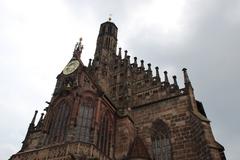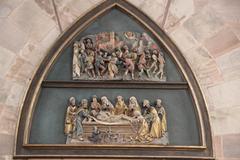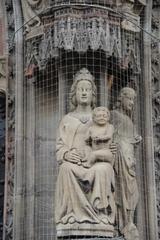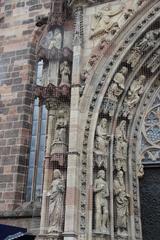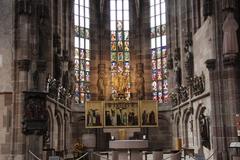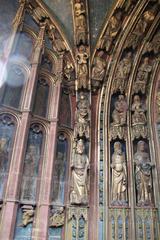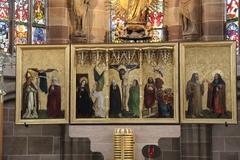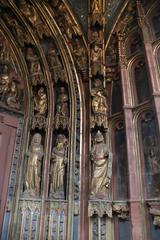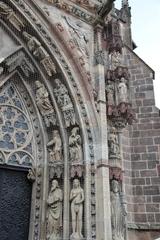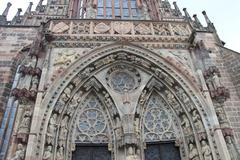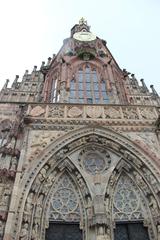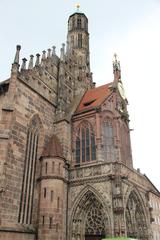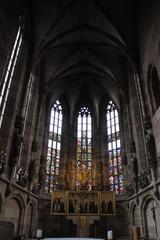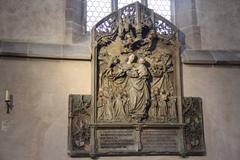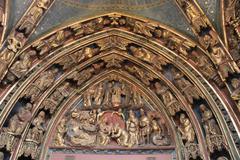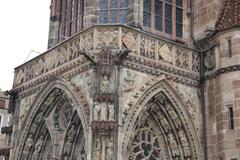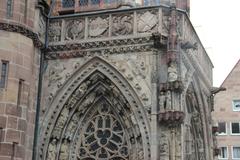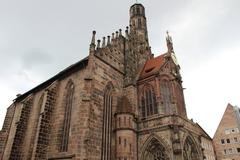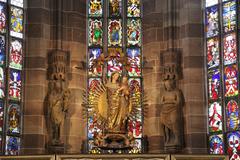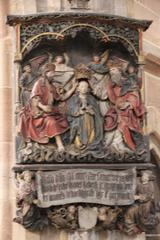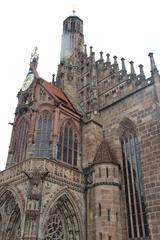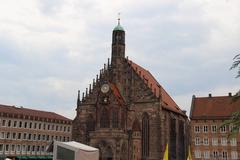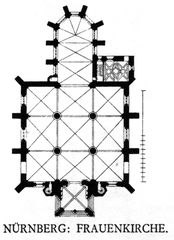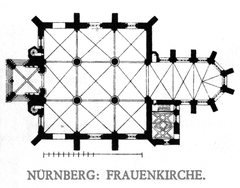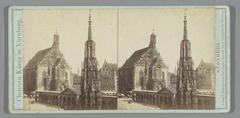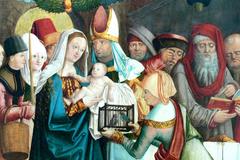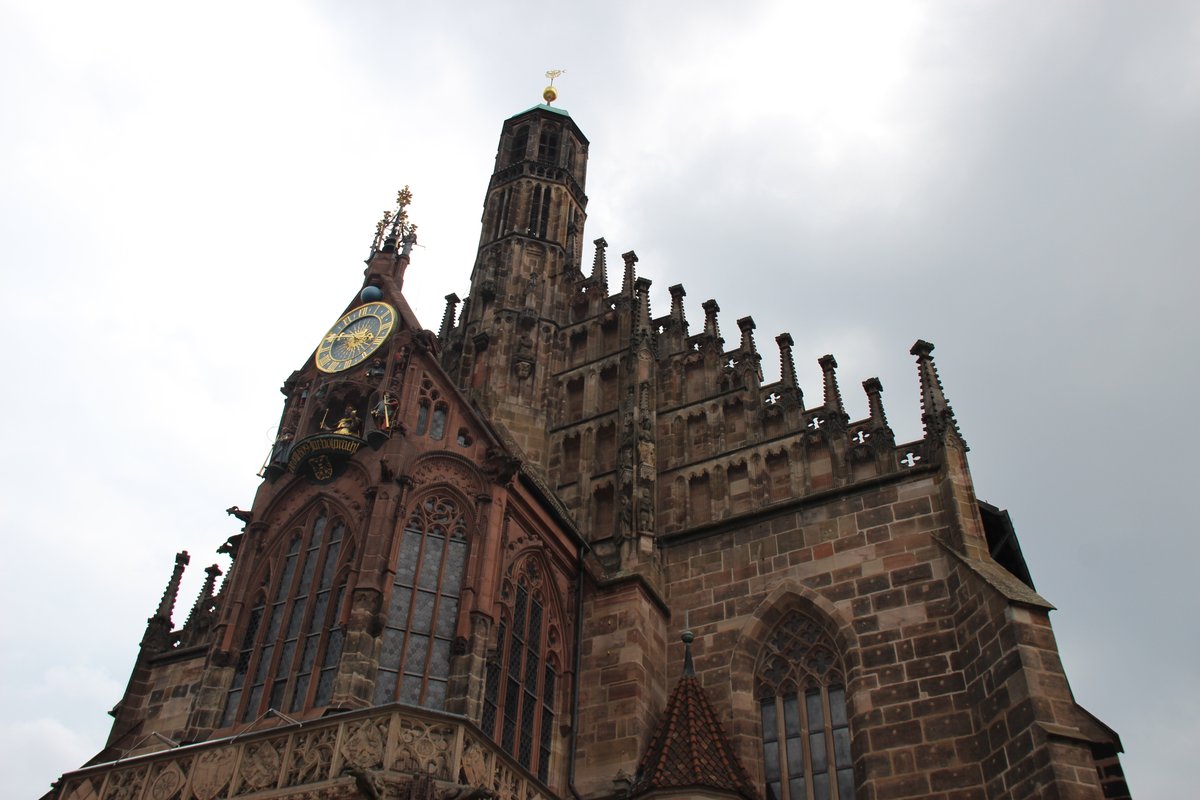
Frauenkirche Nuremberg: Visiting Hours, Tickets, and Historical Sites Guide
Date: 14/06/2025
Introduction
The Frauenkirche (Church of Our Lady) stands as one of Nuremberg’s most iconic landmarks, blending stunning Gothic architecture with centuries of imperial history and vibrant cultural traditions. Erected between 1352 and 1362 on the eastern side of the Hauptmarkt, this church was commissioned by Emperor Charles IV as an imperial chapel, symbolizing both religious devotion and political power in the wake of the Golden Bull of 1356. Today, it remains a living testament to Nuremberg’s layered past, from its medieval foundations through wars and reformations to its careful postwar restoration. Visitors are drawn not only to its architectural artistry—seen in the rose window, intricate façade, and the famed Männleinlaufen clock—but also to its role as a center of community and culture, hosting daily events and seasonal celebrations like the Christkindlesmarkt (tourismus.nuernberg.de; GPSmyCity; QuestoApp).
This comprehensive guide covers everything you need to plan your visit: opening times, ticketing, guided tours, accessibility, travel tips, and nearby attractions.
Table of Contents
- Origins and Construction
- Architectural Significance
- Key Historical Events
- Visiting the Frauenkirche: Practical Information
- Visitor Experience and Tips
- Nearby Attractions
- Frequently Asked Questions (FAQ)
- Conclusion
- References
Origins and Construction
Emperor Charles IV commissioned the Frauenkirche between 1352 and 1362, situating it atop the ruins of a synagogue destroyed in the 1349 pogrom. The church’s construction marked both a physical and symbolic assertion of imperial authority and Christian faith in the heart of medieval Nuremberg. Intended as an imperial chapel, it was central to ceremonies of the Holy Roman Empire, especially following the Golden Bull of 1356, which designated Nuremberg as the city for the first Imperial Diet after each emperor’s election (tourismus.nuernberg.de).
Architectural Significance
Exterior and Façade
The Frauenkirche’s west façade, facing the Hauptmarkt, is an outstanding example of brick Gothic architecture, featuring ornate tracery, pointed arches, a large rose window, and elaborate sculptural details. The stepped gables culminate in an octagonal bell tower with a copper spire visible across the city. Statues of emperors, saints, and allegorical figures adorn the façade, reinforcing the church’s imperial connections.
Männleinlaufen Clock
Installed in 1509, the mechanical Männleinlaufen clock is a beloved attraction. Each day at noon, figures representing the seven prince-electors process around Emperor Charles IV, commemorating the Golden Bull and delighting spectators (GPSmyCity).
Interior and Artistic Treasures
The interior features a single nave with a high vaulted ceiling supported by slender columns and ribbed vaults. The renowned Tucher Altar (circa 1445), gilded high altar, and original stained glass windows are highlights. Sculpted reliefs, woodcarvings, and painted panels tell biblical stories and underscore the church’s role as a center of medieval art.
Materials and Restoration
Constructed primarily from local sandstone with a red clay tile roof and copper spire, the church’s architecture combines durability with artistry. Despite severe damage in World War II, meticulous restorations have preserved its original Gothic character and historic artworks (Nuremberg Tourism; adequatetravel.com).
Key Historical Events
- Imperial Ceremonies: The Frauenkirche was the site of the first public display of the imperial regalia in 1361 and remains linked to the governance of the Holy Roman Empire.
- Reformation: While much of Nuremberg adopted Lutheranism, the Frauenkirche remained Catholic, symbolizing continuity amidst change.
- World War II and Restoration: Heavily damaged during air raids, the church was restored by 1953, preserving its architectural and artistic legacy.
Visiting the Frauenkirche: Practical Information
Location and Access
Frauenkirche stands at Hauptmarkt 14 in Nuremberg’s Altstadt, easily reached by foot, public transport, or local parking garages. The Hauptbahnhof (main train station) is about a 10–15 minute walk away (QuestoApp).
Visiting Hours
- Monday – Saturday: 10:00 AM – 5:00 PM
- Sundays & Public Holidays: 12:00 PM – 5:00 PM
- Note: Hours may vary for religious services or special events. Always check the official website for updates.
Tickets and Admission
- Entry: Free for all visitors; donations are appreciated to support conservation.
- Guided Tours: Available for a fee, bookable online or at the Hauptmarkt tourist information office. Highly recommended for those interested in detailed history and art.
Accessibility
- Wheelchair Access: Ramps and accessible seating are available; some historic areas may be less accessible.
- Special Needs: Guided tours for visually impaired visitors can be arranged upon request.
Facilities
- No restrooms inside; public facilities are available nearby at Hauptmarkt.
- Photography is permitted, except during services; flash and tripods may be restricted.
Visitor Experience and Tips
- Best Times: Early mornings or late afternoons for a quieter visit. The noon Männleinlaufen clock show is a must-see—arrive a few minutes early for the best view.
- Duration: Most visitors spend about 30–45 minutes; art and history enthusiasts may linger longer.
- Dress Code: Modest attire is recommended.
- Language: Most signage is in German; English brochures or audio guides may be available.
- Events: Check the calendar for concerts, recitals, and special services, especially during the Christmas season.
Nearby Attractions
- Kaiserburg (Nuremberg Castle): Medieval fortress with panoramic city views.
- St. Sebaldus and St. Lorenz Churches: Other impressive Gothic landmarks.
- Germanisches Nationalmuseum: Germany’s largest cultural history museum.
- Schöner Brunnen: Intricately designed 14th-century fountain on Hauptmarkt.
- Albrecht Dürer House: Home of the famous Renaissance artist.
The Frauenkirche’s location makes it ideal for exploring Nuremberg’s Old Town on foot, with plenty of cafes and shops surrounding the Hauptmarkt (WanderInEurope; QuestoApp).
Frequently Asked Questions (FAQ)
Q: What are the Frauenkirche’s visiting hours?
A: Monday to Saturday 10:00 AM to 5:00 PM; Sundays and holidays 12:00 PM to 5:00 PM. Confirm on the official website before visiting.
Q: Is there an entrance fee?
A: No, entry is free. Donations support restoration and upkeep.
Q: When does the Männleinlaufen clock show take place?
A: Daily at noon.
Q: Are guided tours available?
A: Yes, book through the tourism office or online.
Q: Is the church accessible for visitors with disabilities?
A: Wheelchair ramps and accessible seating are provided, though some areas may be challenging.
Q: Can photos be taken inside?
A: Yes, except during services; avoid flash and tripods.
Q: Are religious services open to visitors?
A: Yes, regular Catholic services are held; times may affect visiting hours.
Conclusion
The Frauenkirche is more than a Gothic architectural gem—it’s a living archive of Nuremberg’s imperial legacy, spiritual life, and cultural vibrancy. From its origins as an imperial chapel to the daily Männleinlaufen clock show and the festive Christkindlesmarkt opening, the church offers an immersive encounter with the city’s past and present. Its central location, accessibility, and proximity to other historic sites make it a pivotal stop on any Nuremberg itinerary. For the best experience, consult up-to-date information, consider a guided tour, and plan to witness the noon clock spectacle.
For enhanced exploration, download the Audiala app for audio guides and insider tips, and follow us on social media for the latest updates and travel inspiration.
References and Links to Official Websites and Further Reading
- Visiting the Frauenkirche in Nuremberg: Hours, Tickets, and Historical Insights, 2025, Tourismus Nürnberg (tourismus.nuernberg.de)
- Visiting the Frauenkirche in Nuremberg: Architectural Highlights, Hours & Tickets, 2025, GPSmyCity (GPSmyCity)
- Visiting the Frauenkirche in Nuremberg: Hours, Tickets, and Historic Highlights, 2025, QuestoApp (QuestoApp)
- Frauenkirche in Nuremberg in Germany: Overview, Prominent Features, History & Interesting Facts, 2025, Adequate Travel (adequatetravel.com)
- The Beautiful Churches in Nuremberg to See During Your Visit, WanderInEurope (WanderInEurope)
- A Full Nuremberg Experience in Just 3 Days Itinerary, WanderInEurope (WanderInEurope)
- Frauenkirche Attraction, TripHobo (TripHobo)
